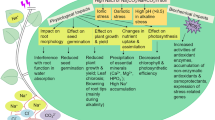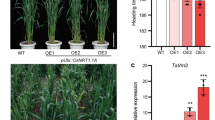Abstract
Bacterial mannitol 1-phosphate dehydrogenase (mtlD) gene was introduced into potato (Solanum tuberosum L.) by Agrobacterium tumefaciens-mediated transformation. Transgenic plants were selected on a medium containing 100 mg l−1 kanamycin and confirmed by polymerase chain reaction (PCR), Southern blotting, and RT-PCR analyses. All of the selected transformants accumulated mannitol, a sugar alcohol that is not found in wildtype potato. Experiments designed for testing salt tolerance revealed that there was enhanced NaCl tolerance of the transgenic lines both in vitro and in hydroponic culture. Compared to 0 mM NaCl, the shoot fresh weight of wildtype plants was reduced by 76.5% at 100 mM NaCl under hydroponic conditions. However, under the same condition, the shoot fresh weight of transgenic plants was reduced only by 17.3%, compared to 0 mM NaCl treatment. The improved tolerance of this transgenic line may be attributed to the induction and progressive accumulation of mannitol in the roots and shoots of the plants. In contrast to in vitro experiments, the mannitol content in the transgenic roots and shoots increased at 50 mM NaCl and decreased slightly at 75 and 100 mM NaCl, respectively. Overall, the amount of accumulated mannitol in the transgenic lines was too small to act as an osmolyte; thus, it might act as an osmoprotectant. However, the results demonstrated that mannitol had more contribution to osmotic adjustment in the roots (but not in shoots). Finally, we concluded that mtlD expression in transgenic potato plants can significantly increase the mannitol accumulation that contributes to the enhanced tolerance to NaCl stress. Furthermore, although this enhanced tolerance resulted mainly from an osmoprotectant action, an osmoregulatory effect could not be ruled out.






Similar content being viewed by others
References
Abebe T, Guenzi AC, Martin B, Cushman JC (2003) Tolerance of mannitol-accumulating transgenic wheat to water stress and salinity. Plant Physiol 131:1748–1755
Almeida AM, Cardoso LA, Santos DM, Torné JM, Fevereiro PS (2007) Trehalose and its applications in plant biotechnology. In Vitro Cell Dev Biol Plant 43:167–177
Behnam B, Kikuchi A, Celebi-Toprak F, Yamanaka S, Kasuga M, Yamaguchi-Shinozaki K, Watanabe KN (2006) The Arabidopsis DREB1A gene driven by the stress-inducible rd29A promoter increases salt-stress tolerance in proportion to its copy number in tetrasomic tetraploid potato (Solanum tuberosum). Plant Biotechnol 23:169–177
Bhatnagar-Mathur P, Vadez V, Sharma KK (2008) Transgenic approaches for abiotic stress tolerance in plants: retrospect and prospects. Plant Cell Rep 27:411–424
Blumwald E (2000) Sodium transport and salt tolerance in plants. Curr Opin Cell Biol 12:431–434
Boyer JS (1982) Plant productivity and environment. Science 218:443–448
Celebi-Toprak F, Behnam B, Serrano G, Kasuga M, Yamaguchi-Shinozaki K, Naka H, Watanabe JA, Yamanaka S, Watanabe KN (2005) Tolerance to salt stress in transgenic tetrasomic tetraploid potato, Solanum tuberosum cv. Desiree appears to be induced by DREB1A gene and rd29A promoter of Arabidopsis thaliana. Breed Sci 55:311–320
Chiang YJ, Stushnoff C, McSay AE (2005) Overexpression of mannitol-1-phosphate dehydrogenase increase mannitol accumulation and adds protection against chilling injury in petunia. J Am Soc Hort Sci 130:605–610
Chomczynski P, Sacchi N (1987) Single-step method of RNA isolation by acid guanidinium thiocyanate–phenol–chloroform extraction. Anal Biochem 162:156–159
Dellaporta SL, Wood J, Hicks JB (1983) A plant DNA minipreparation: version II. Plant Mol Biol Rep 1:19–21
Ghasimi Hagh Z, Rahnama H, Panahandeh J, Baghban Kohneh Rouz B, Arab Jafari KM, Mahna N (2009) Green-tissue-specific, C4-PEPC-promoter-driven expression of Cry1Ab makes transgenic potato plants resistant to tuber moth (Phthorimaea operculella, Zeller). Plant Cell Rep 28:1869–1879
Gopal J, Iwama K (2007) In vitro screening of potato against water-stress mediated through sorbitol and polyethylene glycol. Plant Cell Rep 26:693–700
Hare PD, Cress WA, Van Staden J (1998) Dissecting the roles of osmolyte accumulation during stress. Plant Cell Environ 21:535–553
Heuer B, Nadler A (1998) Physiological response of potato plants to soil salinity and water deficit. Plant Sci 137:43–51
Hobbs SLA, Kpodar P, Delong CMO (1990) The effect of T-DNA copy number, position and methylation on reporter gene expression in tobacco transformants. Plant Mol Biol 15:851–864
Hu L, Lu H, Liu Q, Chen X, Jiang X (2005) Overexpression of mtlD gene in transgenic Populus tomentosa improves salt tolerance through accumulation of mannitol. Tree Physiol 25:1273–1281
Huizhong W, Danian H, Ruifang LU, Junjun LIU, Qian Q, Xuexian P (2000) Salt tolerance of transgenic rice (Oryza sativa L.) with mtlD gene and gutD gene. Chinese Sci Bull 45:1685–1689
Karakas B, Ozias-Akins P, Stushnoff C, Suefferheld M, Rieger M (1997) Salinity and drought tolerance of mannitol-accumulating transgenic tobacco. Plant Cell Environ 20:609–616
Kotuby-Amacher J, Koeing R, Kitchen B (2000) Salinity and plant tolerance. Electronic Publishing AG-SO-03
Loester WH, Tyson RH, Everard JD, Redgwell RJ, Bieleski RL (1992) Mannitol synthesis in higher plants: evidence for the role and characterization of a NADPH-dependent mannose-6-phosphate reductase. Plant Physiol 98:1396–1402
Mahdieh M, Mostajeran A, Horie T, Katsuhara M (2008) Drought stress alters water relations and expression of PIP-type aquaporin genes in Nicotiana tabacum Plants. Plant Cell Physiol 49:801–813
Munns R (2005) Genes and salt tolerance: bringing them together. New Phytol 167:645–663
Murashige T, Skoog F (1962) A revised medium for rapid growth and bioassays with tobacco tissues cultures. Physiol Plant 15:473–479
Patel RM, Prasher SO, Donnelly D, Bonnell RB (2001) Effect of initial soil salinity and subirrigation water salinity on potato tuber yield and size. Agric Water Manage 46:231–239
Patonnier MP, Peltier JP, Marigo G (1999) Drought-induced increase in xylem malate and mannitol concentrations and closure of Fraxinus excelsior L. stomata. J Exp Bot 50:1223–1229
Prabhavathi V, Rajam MV (2007) Mannitol-accumulating transgenic eggplants exhibit enhanced resistance to fungal wilts. Plant Sci 173:50–54
Prabhavathi V, Yadav JS, Kumar PA, Rajam MV (2002) Abiotic stress tolerance in transgenic eggplant (Solanum melongena L.) by introduction of bacterial mannitol phosphodehydrogenase gene. Mol Breed 9:137–147
Rahnama H, Ebrahimzadeh H (2005) The effect of NaCl on antioxidant enzyme activities in potato seedlings. Biol Plant 49:93–97
Ruperez P, Toledano G (2003) Celery by-products as a source of mannitol. Eur Food Res Technol 216:224–226
Sambrook J, Russell DW (2001) Molecular cloning: a laboratory manual. Cold Spring Harbor Laboratory Press, Cold Spring Harbor, New York
Shen B, Jensen RG, Bohnert HJ (1997) Increased resistance to oxidative stress in transgenic plants by targeting mannitol biosynthesis to chloroplasts. Plant Physiol 113:1177–1183
Silveira JAG, Araújo AM, Lima JPM, Viégas RA (2009) Roots and leaves display contrasting osmotic adjustment mechanisms in response to NaCl-salinity in Atriplex nummularia. Environ Exp Bot 66:1–8
Stoop JMH, Williamson JD, Pharr DM (1996) Mannitol metabolism in plants: a method for coping with stress. Trends Plant Sci 1:139–144
Tang W, Peng X, Newton RJ (2005) Enhanced tolerance to salt stress in transgenic loblolly pine simultaneously expressing two genes encoding mannitol-1-phosphate dehydrogenase and lucitol-6-phosphate dehydrogenase. Plant Physiol Biochem 43:139–146
Tarczynski MC, Jensen RG, Bohnert HJ (1992) Expression of a bacterial mtlD gene in transgenic tobacco leads to production and accumulation of mannitol. Proc Natl Acad Sci USA 89:2600–2604
Tarczynski MC, Jensen RG, Bohnert HJ (1993) Stress protection of transgenic tobacco by production of the osmolyte mannitol. Science 259:508–510
Thomas JC, Sepahi M, Arendall B, Bohnert HJ (1995) Enhancement of seed germination in high salinity by engineering mannitol expression in Arabidopsis thaliana. Plant Cell Environ 18:801–806
Waditee R, Bhuiyan NH, Hirata E, Hibino T, Tanaka Y, Shikata M, Takabe T (2007) Metabolic engineering for betaine accumulation in microbes and plants. J Biol Chem 282:34185–34193
Wang W, Vinocur B, Altman A (2003) Plant responses to drought, salinity and extreme temperatures: towards genetic engineering for stress tolerance. Planta 218:1–14
Wilkinson MJ (1994) Genome evolution on potatoes. In: Bradshaw JE, MacKay GR (eds) Potato genetics. CAB International, Wallingford, pp 56–57
Yokoi S, Bressan RA, Hasegawa PM (2002) Salt stress tolerance of plants. JIRCAS Working Report 25–33
Zhifang G, Loescher WH (2003) Expression of a celery mannose 6-phosphate reductase in Arabidopsis thaliana enhances salt tolerance and induces biosynthesis of both mannitol and a glucosyl-mannitol dimer. Plant Cell Environ 26:275–283
Acknowledgments
We thank Mrs. Z. Ghasimi Hagh and Mr. M. R. Shams from ABRII, Karaj, Iran, for their technical assistance.
Author information
Authors and Affiliations
Corresponding author
Additional information
Communicated by T. Moriguchi.
Rights and permissions
About this article
Cite this article
Rahnama, H., Vakilian, H., Fahimi, H. et al. Enhanced salt stress tolerance in transgenic potato plants (Solanum tuberosum L.) expressing a bacterial mtlD gene. Acta Physiol Plant 33, 1521–1532 (2011). https://doi.org/10.1007/s11738-010-0690-8
Received:
Revised:
Accepted:
Published:
Issue Date:
DOI: https://doi.org/10.1007/s11738-010-0690-8




